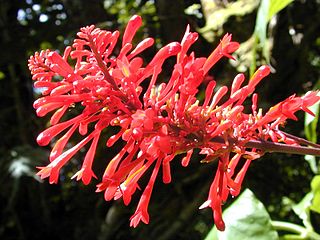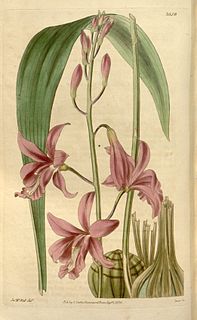
Bletia is a genus of about 30 species of orchids, almost all of which are terrestrial; some are occasionally lithophytic or epiphytic. It is named after Spanish botanist and pharmacist Don Luis Blet. The genus is widespread across Florida, Mexico, Central America, the West Indies, and South America as far south as Argentina.
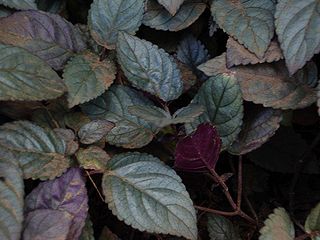
Hemigraphis is a genus of plants in the family Acanthaceae, consisting of about 30 species native to tropical Asia. Hemigraphis is sometimes included in the genus Strobilanthes. It is characterized by the grayish green leaves, stained with red purple above and darker purple beneath. It is a prostrate growing plant with spreading, rooting stems.
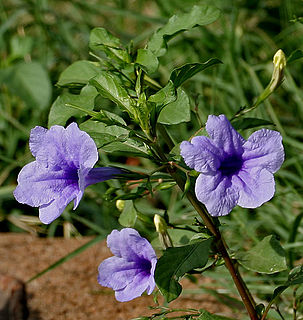
Ruellia is a genus of flowering plants commonly known as ruellias or wild petunias. They are not closely related to petunias (Petunia) although both genera belong to the same euasterid clade. The genus was named in honor of Jean Ruelle, herbalist and physician to Francis I of France and translator of several works of Dioscorides.

Polyscias is a genus of flowering plants in the family Araliaceae. They bear pinnately compound leaves.

Netrocoryne repanda, the bronze flat, eastern bronze flat, or eastern flat, is a butterfly found in Australia, belonging to the subfamily Pyrginae of the family Hesperiidae.
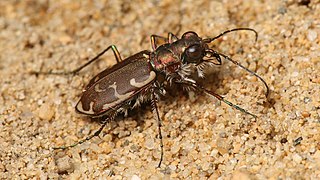
Cicindela repanda, commonly known as the bronzed tiger beetle or common shore tiger beetle, is a species of tiger beetle that measures 10–13 millimetres (0.39–0.51 in) long, lives in most of North America. Its labrum is small with one tooth and the pronotum is coppery and hairy. The shoulder marking touches or nearly touches the middle band. It is usually seen in spring and summer and it lives in sand, gravel, or clay soil. Its food is many insects and some fruit. The species have a two-year life cycle. It can be found all across sand dunes around the great lakes The species comprises three subspecies: C. repanda repanda, C. repanda novascotiae, and C. repanda tanneri.

Peziza repanda, commonly known as the Palomino cup or recurved cup, is a species of fungus in the genus Peziza, family Pezizaceae.

Mocis repanda, the striped grass looper, is a species of moth of the family Erebidae. It was described by Johan Christian Fabricius in 1794. It is found in Central America and the Caribbean, including Cuba, the Dominican Republic, Guadeloupe, Guatemala, Jamaica, Puerto Rico and Saint Thomas. Strays can be found in the United States, up to southern Texas as well as subtropical Africa south of the Sahara, including the islands of the Indian Ocean.
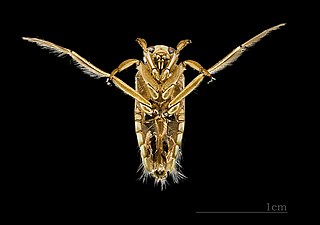
Notonecta, or the common backswimmer, is a genus of backswimmer insects in the family Notonectidae. Species in this genus include:

The wavy lined mallow moth is a moth of the family Noctuidae. It is found in the southern United States from South Carolina to Florida, west to Texas, south through Guatemala, Panama, the Antilles, Paraguay, Colombia, Venezuela, Guyana and Brazil to Argentina.
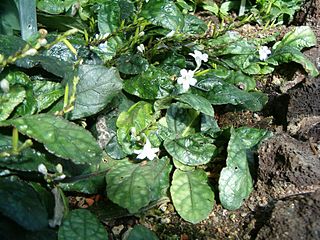
Ruellia drymophila is a plant species in the Acanthaceae family, native to China.
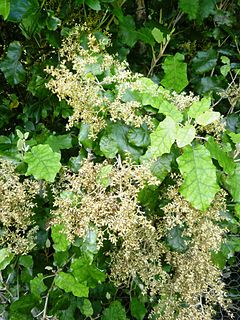
Brachyglottis repanda is a small, bushy tree or tall shrub endemic to New Zealand. It grows to a height of 5 to 7 metres. The large leaves with a soft furry underside have been referred to as "bushman's toilet paper".

Lithophyllon repanda is a species of mushroom or disc coral in the family Fungiidae.This species is able to move to another location on occasion. The International Union for the Conservation of Nature (IUCN) rated it as a least-concern species and it was originally described by Dana in 1846. It occurs at depths of 1 to 30 metres.
Periploca repanda is a moth in the family Cosmopterigidae. It was described by Ronald W. Hodges in 1978. It is found in North America, where it has been recorded from Texas, Arizona and California.
Acacia repanda is a shrub belonging to the genus Acacia and the subgenus Juliflorae. It is native to a small area in the southern Wheatbelt region of Western Australia.
Physaria repanda, commonly known as the Indian Canyon twinpod is a species of mustard plant distributed in Utah. It is a perennial wildflower.
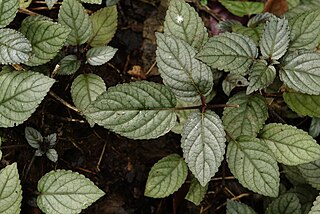
Hemigraphis alternata is a member of the Acanthaceae family native to Java. It is a prostrate plant with purple colored leaves.

Acanthoideae is a subfamily of plants in the family Acanthaceae.
Panopoda repanda, the orange panopoda, is a species of owlet moths, etc. in the family Erebidae. It is found in North America.

Boronia repanda, commonly known as the granite rose, repand boronia or border boronia, is a plant in the citrus family Rutaceae and is endemic to an area near the eastern border between New South Wales and Queensland in Australia. It is a small erect, woody shrub with many branches, thick warty, oblong leaves and pink, rarely white flowers arranged singly in leaf axils.

